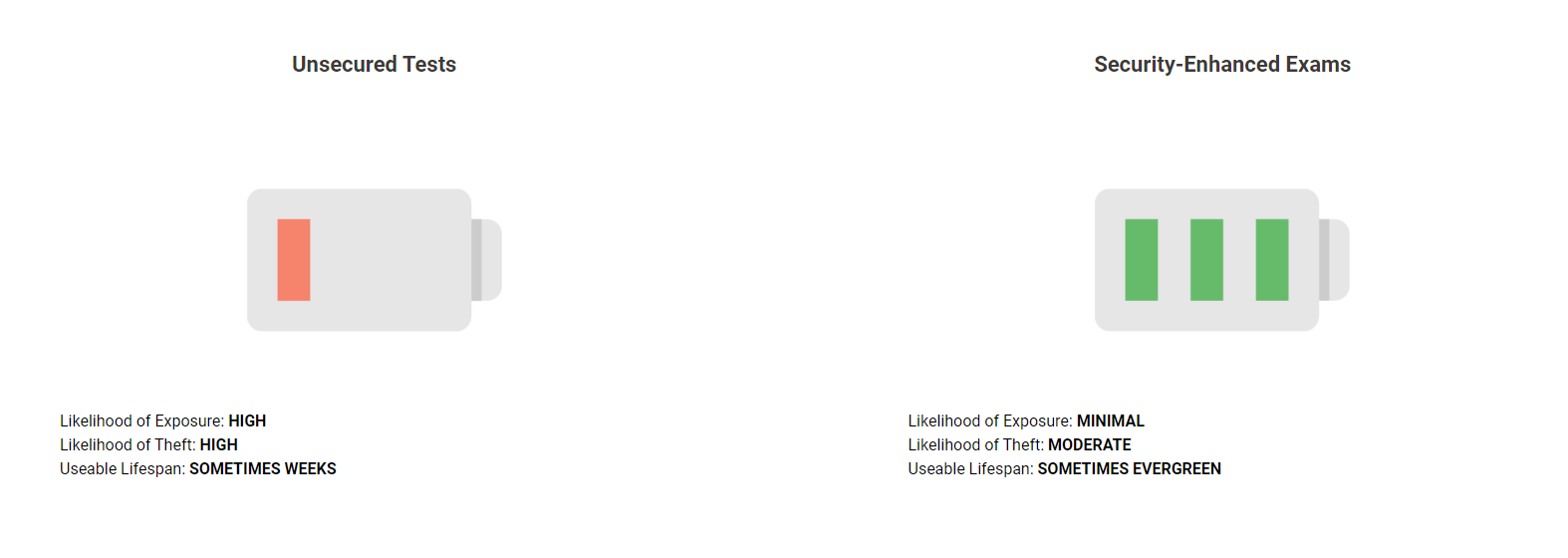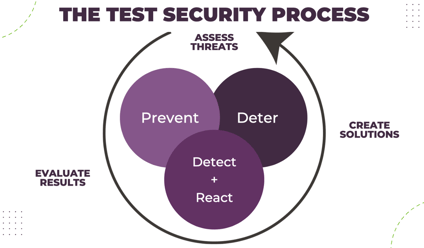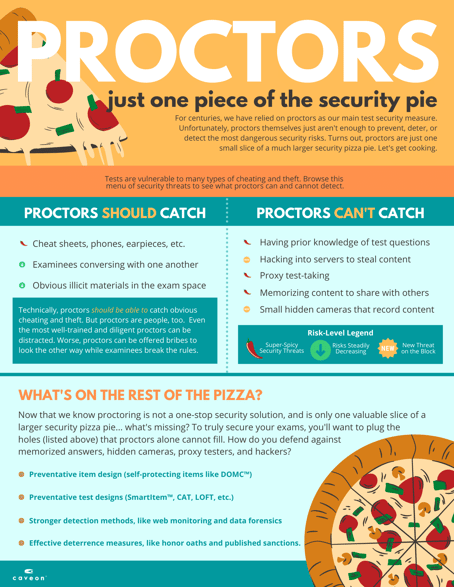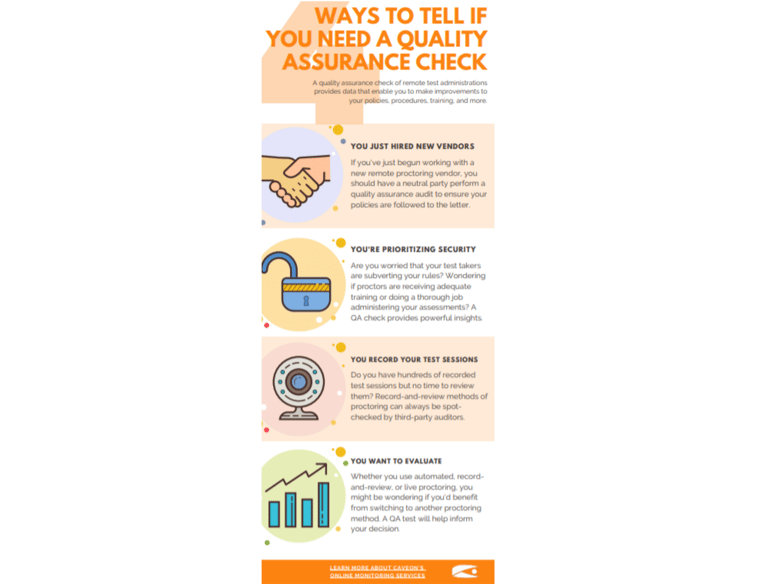CAVEON SECURITY INSIGHTS BLOG
The World's Only Test Security Blog
Pull up a chair among Caveon's experts in psychometrics, psychology, data science, test security, law, education, and oh-so-many other fields and join in the conversation about all things test security.
Can Online Tests Detect Cheating?
Posted by Alison Foster
updated over a week ago
Can Online Tests Detect Cheating?
The short answer is yes. With the right procedures in place, any online exam can detect cheating. Authentication measures, web monitoring, data forensics, and proctoring (just to name a few) all make it hard for test takers to get away with ever cheating on your test.
The Facts About Cheating on Online Tests
If you're a testing program, it’s likely you already know (and bemoan the fact) that cheating on tests is a very real problem.
(Just Google it and you will find thousands of videos, websites, blogs, and forums discussing ways to cheat).
Let’s start with a few facts about cheating on online tests:
- While online testing makes some types of cheating easier, it is not inherently riskier than in-person testing. Anyone who tells you that administering exams in person is more secure is selling you something.
- On the flip side, online testing is not inherently more secure than in-person testing. Anyone who tells you that administering exams online is more secure is also selling you something.
- In summary, security is a problem no matter what method you use to administer your exams. This includes online testing.
Now onto the good news…
- While it is possible to cheat on online tests, there are ways to stop it. You do not need to accept cheating as a fact of life.
The same way a bank installs security features to stop people from breaking into your accounts and catch them if they do, you can prevent and detect cheating on your online exams before it has the chance of undermining your program.
What Types of Online Cheating Should You Be Worried About?
There are myriad creative and devious ways that people cheat on online tests.
It would be impossible to write them all down (as I’m sure some diabolical human is thinking up a new scheme even as I write this sentence).
I also don’t want to give anyone any ideas. (“Why hadn’t I thought of that?! Let’s give that a try!”)
Instead, I am going to outline a few of the most important categories of cheating that occur on online tests. (You can find a list of complete cheating categories in this white paper and a list of all the test fraud threats in this white paper as well.)
Watch out for examinee cheating through:
Let’s look at each of these categories of cheating in turn.
Cheating Using Pre-Knowledge:
This is the granddaddy of all cheating methods. Cheating using pre-knowledge is when a person gets an advanced warning of what specifically will be on the test.
For example, an examinee can ask a friend to take the test first and write down the answers, purchase the questions/answers from a braindump site online, or read about live test questions in an online forum. From there, the examinee then memorizes the questions/answers and uses what they remember to cheat and get a better score on the test. (Watch this video for more information about pre-knowledge.)
This method of cheating is incredibly widespread, and it is very common. Stealing and selling exam content is a profitable business. There are thousands of formal braindump sites built exactly for this purpose, and there are many “test prep” forums being used to share answers, too.
(Side note, if battling braindumps a problem for your program, we have an article on what to do about braindump sites and more information in point #6 below.)
More than pre-knowledge’s prevalence though, the tricky part (and what makes it so incredibly dangerous) is that it is nearly impossible to catch during the test. A test taker who memorized an answer key looks exactly like a test taker who is simply well-prepared for the exam! One person is cheating, and one is being honest, yet the proctor cannot tell the difference.
Pre-knowledge is an easy and effective way for people to cheat on an exam. Don’t panic though; there are ways to stop it. (Read on! We get to this shortly.)
Cheating by Colluding with an Expert
Another method examinees use to cheat on online tests is colluding with an expert on the exam.
For example, this could involve getting unauthorized aid from the online proctor (this is one reason to never let proctors see the content of a test, which we explain in this list of proctoring best practices). As another example, examinees have been caught using hidden cameras, two-way radios, or microphones to be fed the answers to the test.
While not as prevalent or as easy to get away with as using pre-knowledge, collusion is still a common form of cheating. Recent examples include the bribing of proctors in the Varsity Blues scandal. It is a bold method, but when pulled off successfully, this type of cheating can almost guarantee a high score on an exam.
Cheating Using Unauthorized Aids
A fairly straightforward form of cheating is when a test taker uses unauthorized aids during an exam.
A few examples include feeding test questions to an AI tool, hiding an elementary-style cheat sheet under a keyboard, using a hidden cellphone to Google answers during an exam, tattooing answers on your arm, etc. I stop there because, truly, the options are endless. (In my eighth-grade science class, one classmate wore a t-shirt with a picture of the periodic table on the front. Needless to say he aced the test.) I've also seen countless YouTube videos, TikToks, and Reddit threads outlining thousands of ways to sneak helpful information into your test.
While all this may seem disheartening, fear not.
Like the other categories of cheating, there are ways to put an end to this type of cheating (you can jump ahead if you so please).
Cheating Using a Proxy Test Taker
The final category of cheating commonly used on online tests is using a proxy test taker.
Proxy testing is when a test taker hires someone (whether a friend or a professional) to pretend to be them and take the test in their place.
When it comes to online testing, these “proxies” can be located in other countries around the world. And with how easy it is to create a fake ID, they don’t even need to look like the test taker. A somewhat rather easy route to forge a great score, proxy test taking is growing rapidly to cheat on online exams.
The Key to Detecting Cheating on Online Exams
The key to detecting and stopping cheating on your online exam?
Use the proper test security methods & know that it takes a comprehensive solution—one that employs multiple security measures—for your security system to be effective.
It’s understandable to be a bit taken aback when thinking about the many ways dishonest test takers can cheat on online exams.
But don’t panic—the key parts of that last sentence are the two words can be... It can be easy to cheat on an online exam. But it doesn’t have to be!
The truth is that the vast majority of online exams make almost no effort to stop cheating. You get to decide... will your testing program be different?
As an example of the importance of an effective, comprehensive security system, just imagine you are installing a security system for your house. A few things to consider:
- Would it be very effective if you just hired someone to walk past your front house every few hours? Probably not. (We're looking at you, old-school proctoring.)
- What if you also added motion-detecting lights? Better, but still not great.
- What about building a fence and adding a trained guard dog? Yep, even better, but still pretty easy to bypass.
- What about adding sensors to your windows and doors? And adding a video camera or two? That’s definitely more secure.
There are dozens of ways to protect your home, but no single effort on its own is very effective (though it's true that some methods are better than others).
Still, the best way to ensure your home is safe is to make sure you employ a broad range of security measures that complement each other.
The same is true for test security!
Let’s talk specifics.
How to Stop Cheating on Online Exams
The thorough answer for how to stop cheating on your online test is: “You need to employ a series of test security solutions that prevent, deter, detect, and react to test threats.”
I invite you to learn more about the security process in this article (it really is important), but for now...
Let’s focus on the solutions:
- Write test questions that are harder/impossible to cheat on
- Publicize your test security measures
- Implement better authentication methods
- Conduct quality assurance checks
- Search the web for stolen test content
- Analyze your test data
- Conduct investigations and follow through with sanctions
****Disclaimer: This list is by no means complete, and new ways to stop cheating are growing rapidly. But we consistently update our content and create more helpful resources to keep you in the know***
1. Stop relying on proctors.
Proctors should be used when appropriate (learn to identify the difference between a mediocre and a great proctoring solution).
With that said, proctors should never be relied on as your sole security solution.
Despite what we've been told, proctors are not effective at stopping cheating on online exams by themselves—proctors are just a piece of the security pie and must be used in conjunction with other solutions.
Read more about the security strengths and weaknesses of proctors in our white paper.
2. Write test questions that are harder/impossible to cheat on.
I mentioned earlier that pre-knowledge is the most dangerous type of cheating (and the hardest to catch).
But it is possible to prevent pre-knowledge from ever being possible in the first place: by designing your test and test questions to protect themselves. (You can do this yourself or hire a dedicated team to write and design your exam for you.)
A few methods that can stop pre-knowledge in its tracks:
-
- Discrete Option Multiple-Choice™ (DOMC) items
- Adaptive test designs (like CATs)
- Giant item banks (done easily through AIG)
- SmartItem™ technology (100% pre-knowledge proof)
These testing innovations make it possible for you to create an exam that displays unique test questions to each test taker, which means examinees won't benefit from going online and memorizing questions & answers that someone else stole.
Braindumps won't help them, because they won’t see those same questions on their exam!

3. Publicize your test security measures.
It sounds crazy, but you should absolutely always publicize your security efforts.
(It is an under-rated, yet powerful security tool!)
For example, you can publicize your security measures by broadcasting the steps your testing program takes to secure your exams. In that same breath, you can broadcast the consequences for cheating when they get caught.
No matter the method, make potential cheaters believe that they will get caught, and assure them that the consequences aren’t worth it.
Do this, and you can deter many cheaters before they even start the test. Better still, you may dissuade opportunistic entrepreneurs from stealing or sharing your content with others for profit—especially when the costs outweigh the benefits.
(We go into depth on how to publicize your test security measures in another article.)
4. Implement better authentication methods.
Authenticating a test taker is the process of asking three vital questions:
-
-
“Is this person who they say they are?”
- “Do we have the right candidate for the right exam?”
- “Could this be an imposter taking a test for someone else?”
-
Unsurprisingly, implementing strong authentication tools is much more difficult than it sounds.
For example, fake IDs are incredibly tricky to catch, particularly when the examinee takes an online test and shows their ID over a webcam.
Luckily, there are tools—including biometrics, anatomy scans, and facial recognition—for identifying and authenticating test takers and solving these exact scenarios.
Artificial Intelligence is continually making these tools more efficient and effective in verifying an individual’s identity, too. Just make sure to pick a solution that protects the personal privacy of the test taker as well.
5. Conduct quality assurance checks.
How do you know if examinees and proctors are following your rules? How can you know if the security policies you put in place are actually working?
The hard truth is that the only way to really know if your security is working is to take the time to thoroughly check and see.
(This is particularly important if you have recently switched to online testing or are using new vendors.)
Regular quality assurance checks can tell you if you need to make improvements to your security policies, procedures, trainings, etc. You can learn more about implementing effective quality assurance checks on pages 9-18 of the Security Boot Camp: Part 3.
6. Search the web for stolen test content.
One of the easiest, most reliable ways for examinees to cheat is to find the answers to your test online.
In this day and age, you can no longer assume that your test questions are safe or secure.
The painful truth is that, more often than not, they aren’t.
For example, before hiring Caveon's Web Patrol® team, one testing program had their test questions stolen and shared on the internet within days of publishing them.
To determine whether your test is victim to this malicious form of cheating and theft, conduct web monitoring efforts, whether on your own or with Web Patrol. (You can learn how to DIY in the Security Boot Camp: Part 3, pages 20-28, or reach out to our team.)
Once you've determined whether your test content has been shared online, how widespread the problem may be, and then get your content removed, starting with DMCA takedown notices. After you’ve pinpointed whether your exam content is online, use what you learn to identify those who may have used that illicit material to cheat on a test.
(And if you want something really cool, consider watermarking your test questions to track down just who stole your questions in the first place.)
7. Analyze your test data.
Did you know your test’s results contain clues about whether cheating and theft have occurred?
Trained psychometricians know how to analyze your testing data. They can use it to detect cheating and pinpoint exactly who cheated on your online exam. You can learn more about this process in our ultimate guide to data forensics, but in all, data forensics is the single most powerful tool available for detecting cheating.
After your exam is over, compare testing data from your examinees (including response times, wrong-to-right answer changes, etc.) and use that data to uncover who may have cheated. This gives you a head start to take the appropriate action if there was in fact cheating, and if your investigation uncovers any malfeasance, it may be time to invalidate their scores.
Just remember: data forensics (like web patrol) only detects a problem after it has already occurred. It is the quintessential “closing the barn door after the horse has bolted” problem.
The best thing you can do is combine great preventative measures (like secure item types in the second point listed above) with regular data forensics and other security measures. That way, you’ll stop most people from cheating and then detect those few who do get past your security defenses!
8. Conduct investigations and follow through with sanctions.
After you have holistically prevented cheating from happening (steps 1-5) and used security solutions to detect those who managed to get past your defenses (steps 6-7), you should thoroughly investigate flagged incidents.
For example, suppose your data forensics report has isolated a handful of suspicious test scores. In that case, you must follow up with a careful investigation—one that is neutral, fair, and legally defensible. It would be best if you then took the appropriate actions to fairly sanction those who cheated by invalidating their test scores, pursuing legal action, etc.
All in all, the simple truth is that if there are no consequences for cheating, why wouldn’t people cheat?
Without the above measures in place, you can pretty much count on cheating impacting your test scores.
And no matter what, whether online or in-person, if there are benefits to getting a good score, there will always be those individuals who try to cheat to get it.
To the age-old question, "Can online tests detect cheating," yes they can. But the trick is understanding that cheating isn’t something your testing program has to put up with. With the right measures in place, you can prevent cheating from having an effect on your exams.
Just be sure your security measures involve a series of test security solutions—ones that work together to prevent, detect, deter, and react to security threats.
When in doubt, just reach out to our team of professionals, or check out how Caveon's online testing tools and proprietary item designs can help. (It’s what we do!)
Alison Foster
View all articlesAbout Caveon
For more than 18 years, Caveon Test Security has driven the discussion and practice of exam security in the testing industry. Today, as the recognized leader in the field, we have expanded our offerings to encompass innovative solutions and technologies that provide comprehensive protection: Solutions designed to detect, deter, and even prevent test fraud.
Topics from this blog: Test Security Consulting Data Forensics Exam Development Investigating Security Incidents K-12 Education Web Monitoring Test Security Basics Proctoring Detection Measures Deterrence Measures Prevention Measures Certification Test Security Plan Higher Education Online Exams Medical Licensure
Posts by Topic
- Test Security Basics (34)
- Detection Measures (29)
- K-12 Education (27)
- Online Exams (21)
- Test Security Plan (21)
- Higher Education (20)
- Prevention Measures (20)
- Test Security Consulting (20)
- Certification (19)
- Exam Development (19)
- Deterrence Measures (15)
- Medical Licensure (15)
- Web Monitoring (12)
- DOMC™ (11)
- Data Forensics (11)
- Investigating Security Incidents (11)
- Test Security Stories (9)
- Security Incident Response Plan (8)
- Monitoring Test Administration (7)
- SmartItem™ (7)
- Automated Item Generation (AIG) (6)
- Braindumps (6)
- Proctoring (4)
- DMCA Letters (2)
Recent Posts
SUBSCRIBE TO OUR NEWSLETTER
Get expert knowledge delivered straight to your inbox, including exclusive access to industry publications and Caveon's subscriber-only resource, The Lockbox.




